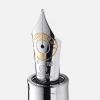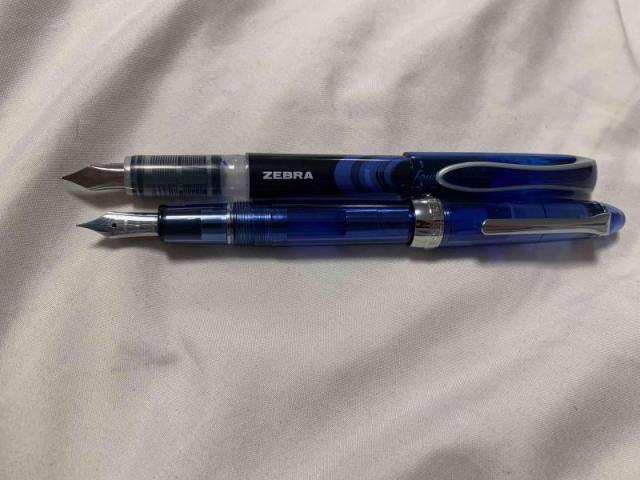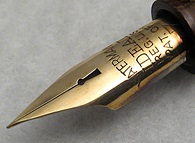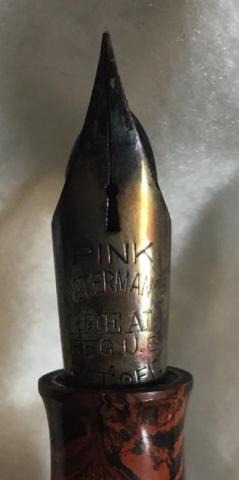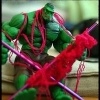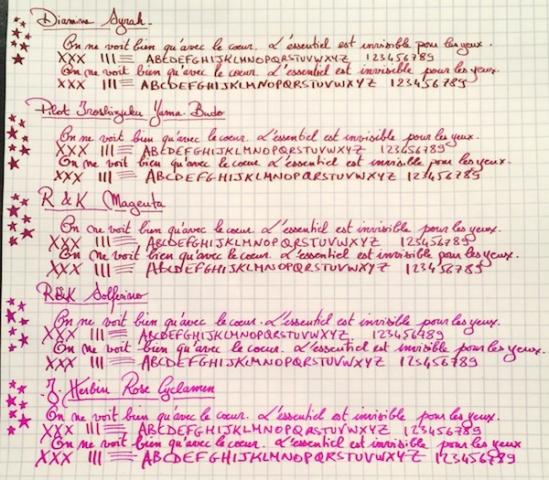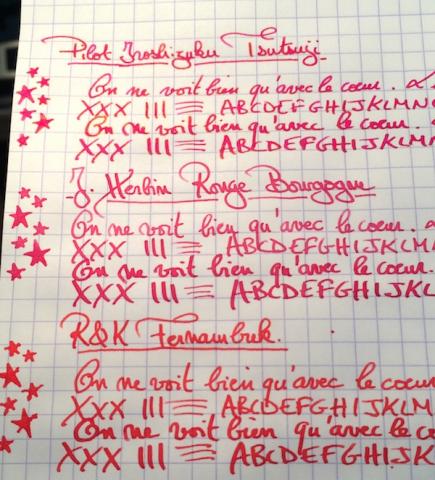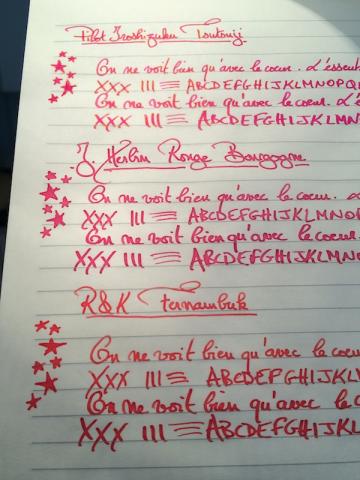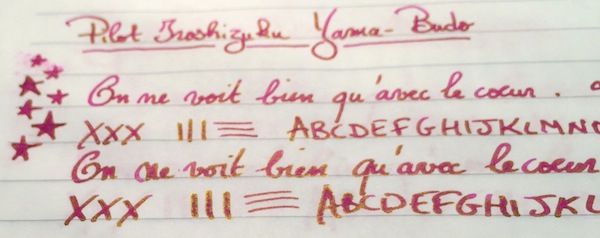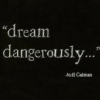Search the Community
Showing results for tags 'pink'.
-
Hello! I felt the need to create this post since I can't find anyone else talking about it and maybe it's just me that I happened to contaminate two (maybe three?) different ink bottles of the same color. I hope the pictures I took serves as good reference to demonstrate what happened...
- 13 replies
-
- cream of earl
- ferris wheel press
-
(and 7 more)
Tagged with:
-
*comes in a 3 oz glass bottle * it's definitely pink *more of a blue-pink than an orange-pink (the third photo looks the most accurate to me, but your monitor may show it differently) *dries pretty fast, under 5 seconds *highlights over a variety of inks without smearing *not water resistant (that's...
-
TAG Kyoto – kyo-no-oto – imayouiro TAG is a stationary shop in Kyoto (Japan) that produces some interesting soft watercolour-style inks. With the kyo-no-oto series, they produce a line of inks that replicates traditional Japanese dye colours. According to available online info,...
- 8 replies
-
- tag kyoto
- kyo-no-oto
-
(and 2 more)
Tagged with:
-
Hello Inky Friends! It has been quite awhile since I shared my comparisons of pink and purple inks here: https://www.fountainpennetwork.com/forum/topic/274481-pink-purple-ink-comparisons/ I have updated the list with a few new inks (mostly samples, but a few are bottles as well.) Again I wil...
-
desaturated.thumb.gif.5cb70ef1e977aa313d11eea3616aba7d.gif)
PenBBS Fountain Pen Ink No.178 Rose Quartz – a lazy review
A Smug Dill posted a topic in Ink Reviews
Here's a weird ink, probably closely comparable to Jacques Herbin Nude By Marc-Antoine Coulon (which I don't have), that I expected and really wanted to like, but in which I'm sadly disappointed by its performance characteristics that make it nigh unusable and useless. Colour: It really... -
desaturated.thumb.gif.5cb70ef1e977aa313d11eea3616aba7d.gif)
PenBBS no.178 Rose Quartz ink review sheet — scan
A Smug Dill posted a gallery image in FPN Image Albums
From the album: Ink review
The colour of this ink simply defies capture with my Canon scanner, even with a colour reference card next to it; and no amount of colour correction post-processing in GIMP can make it look anything close to what I see. The photo here presents the ink colour relatively more accurately:...© A Smug Dill
- 0 B
- x
-
desaturated.thumb.gif.5cb70ef1e977aa313d11eea3616aba7d.gif)
PenBBS no.178 Rose Quartz ink review sheet — photo
A Smug Dill posted a gallery image in FPN Image Albums
From the album: Ink review
The photo has been scaled down to approximately 114dpi, so that it is rendered true to size on the screen of my 13-inch MacBook Pro. The colour shown in the image, when displayed on my screen, is fairly close to what I see on the page — when the incident light makes the colour of the pap...© A Smug Dill
- 0 B
- x
-
Here is another sort-of pink ink that was generously donated by amberleadavis, famed Inky! En-Abe-Lawyer. Wancher is a Japanese concern dealing in pens and inks since 1987. This particular ink comes in a rectangular plastic bottle and is my first experience with the brand. With a heavier swab a...
-
Hip stationers "Berlin Notebook" released the excellent Blue No.1 ink a few months back. What colour would you guess, their second ink would be? Well obviously ... blinding neon pink! Like Blue No.1 it's an artist created ink, in this case Caroline Corleone, who has an interesting tale to tell abo...
-
Colour: More of a dark pink than a red Flow: Moderate Feathering: Not observed on Rhodia Dotpad 80g/m² paper, looking closely at the thinnest hatching lines, and words/glyphs ‘reverse-written’ with the nib upside-down (i.e. the bottom of the feed facing up) Show-through: Low to nil...
-
Hello people of FPN! It’s been over a year since I’ve last posted here, I’ve been busy with my first year and a half of college. In the last month or so, though, I’ve started lurking around reading the forums again, and I’ve been wanting to write another review. I just needed to find a pen that w...
-
- disposable
- zebra
-
(and 7 more)
Tagged with:
-
These inks will be part of the fade test. Here are the current inks compared. http://www.sheismylawyer.com/2018-Ink/2018-05/slides/2018-05-03_Ink_1.jpg Much to my surprise, you can see some bleed through. http://www.sheismylawyer.com/2018-Ink/2018-05/slides/2018-05-03_Ink_2.jpg
-
Hello everyone, I am tempted by one Waterman's #7 pen with PINK nib. I mean - I'm tempted to shell out $$$$ and finally get one. I own #7 with YELLOW nib, #5 with RED nib, and several other vintage Waterman's with different nibs. While I was looking at the pen with PINK nib, one thing occurred t...
-
-
- j herbin
- rouille dancre
-
(and 4 more)
Tagged with:
-
Here are a couple scans of some pink and purple ink comparisons. All these were written with a glass dip pen on a Rhodia dot pad. I did my best to represent the colors of the inks but as always please remember that what I see on my screen is probably a little different than what you see. I hope...
-
This past March when I was ordering Style Dee inks, I make the shipping more reasonable I needed another ink. I decided to give this pink a try. I don't have many pink inks. So it got added to the collection. It's probably one of the few that won't remain. There's nothing wrong with the ink. It's...
-
Robert Oster Signature - Plumb Nut Robert Oster is an Australian ink maker that is well-known for its unique range of colours. On his website he describes our shared love quite eloquently: "Robert Oster Signature originates from one of the most famous wine producing regions of the world, the Coona...
- 11 replies
-
- robert oster
- signature
-
(and 2 more)
Tagged with:
-
It's a PINK. My first pink. I bought this because I wanted to complete my R&K set, and also wanted to try something that is out of my comfort zone. I don't know what to think of this one. It's not bad. It's not ugly. Quite pretty actually. But it's pink. It reminds me of some pink backpacks for litt...
-
I have a slight pink problem. I have little girls, let's blame it on them. This ink performed really well. It dries really fast, is super saturated, and is surprisingly water resistant for a red. Also, it is seriously solid - really no feathering to speak of even on really poor copy paper. It's in...
-
I've been lurking here for a long time but joined today as I saw Noodler's Tchaikovsky and Rachmaninov did not have ink reviews but are both in my possession. I love looking at ink reviews, even the rubbish ones, so I was inspired to make my own modest contribution. This ink is probably not a good...
-
I've been wanting to try some kind of pinkish ink for a while. I didn’t want a pastel or cotton-candy pink, but other than that I was pretty open, so after going through the FPN boards and using the Goulet swatch tool, the eight finalists ranged from burgundy to magenta to purplish and reddish pinks...
- 50 replies
-
In May 2014 Kingdom Note came out with a new line of specialty inks from Sailor based on Mushrooms. At that time they were relatively easy to obtain, but only two of the inks were colors that appealed to me then, so I passed on the others. Recently several became available again as they sometimes do...
- 9 replies
-
- sailor
- kingdom note
-
(and 3 more)
Tagged with:
-

(P)Ink Shoot-Out : Callifolio Andrinople Vs Edelstein Turmaline
namrehsnoom posted a topic in Ink Comparisons
(P)ink Shoot-Out : Callifolio Andrinople vs Edelstein Turmaline Given that today is Valentines Day, I thought it would be fun to pitch a fight between two inks that are definitely up to the occasion. And what a surprise ! These turn out to be pink inks ! I’m not a pink ink person myself, but thes...- 4 replies
-
- callifolio
- andrinople
-
(and 3 more)
Tagged with:
-
I didn't expect to like the color of this ink as much as I did. I'm not usually a fan of pinks, but winter has me craving more lively colors. I was afraid this would have too much orange for my liking, but it is a very nice blue-pink that is moderately saturated. It performs very well & dries qui...
- 14 replies
-
- ink review
- kwz
-
(and 2 more)
Tagged with:


12_58_52.thumb.png.e1966e2f738e9054f7f9141326018311.png)
13_46_31.thumb.png.26afb3c3a440d08cfb17f4f19dd5f466.png)
13_46_44.png.e2f3beba9bb3a83bd931d0bd2db4abb6.png)
13_47_32.png.5921629837f65e73fc8dc7b887013dd4.png)
.thumb.jpeg.1fdf46aab7cbfc85329beef03395131c.jpeg)

13_53_04.thumb.png.317dfee5a2fa4bfe2e1bb073a6955008.png)


.jpg.5dc5290739dc541e5d7517a060ad1b0e.jpg)
.jpg.9d38aec348399867cd99f363f9627186.jpg)


